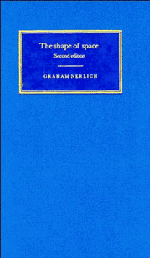Book contents
- Frontmatter
- Contents
- Preface
- Introduction
- 1 Space and spatial relations
- 2 Hands, knees and absolute space
- 3 Euclidean and other shapes
- 4 Geometrical structures in space and spacetime
- 5 Shapes and the imagination
- 6 The aims of conventionalism
- 7 Against conventionalism
- 8 Reichenbach's treatment of topology
- 9 Measuring space: fact or convention?
- 10 The relativity of motion
- Bibliography
- Index
5 - Shapes and the imagination
Published online by Cambridge University Press: 04 December 2009
- Frontmatter
- Contents
- Preface
- Introduction
- 1 Space and spatial relations
- 2 Hands, knees and absolute space
- 3 Euclidean and other shapes
- 4 Geometrical structures in space and spacetime
- 5 Shapes and the imagination
- 6 The aims of conventionalism
- 7 Against conventionalism
- 8 Reichenbach's treatment of topology
- 9 Measuring space: fact or convention?
- 10 The relativity of motion
- Bibliography
- Index
Summary
Kant's idea: things look Euclidean
The aim of this chapter is to describe what it would be like to live in a markedly non-Euclidean world. We want a description that appeals to the visual and tactile imagination. How would things strike the eye or cleave to the touch in a strange space?
On the face of it, this is an entertaining exercise which we can start with real hope of success. Some effort of abstract thought and some agility of the visual imagination will no doubt be needed. But the task certainly looks possible. The non-Euclidean geometries are consistent. There are detailed analytical descriptions of non-Euclidean spaces, which are consistent if arithmetic is. (For an example in analytic treatments of projective spaces see Adler 1958, chapter 12.) Looking in another direction, we find that we can lay down axioms of non-Euclidean geometry and reinterpret their primitive terms as true of certain objects in Euclidean space as we did at the end of chapter 3 (see also Somerville 1958, chapter 5; Hilbert and Cohn-Vossen 1952, §§34–9). Neither of these gives us the description of visual experience that we want. But they should encourage us to think that we can find it.
Nevertheless, the view that our imaginations are bound by Euclidean limits has some supporters. Kant held that Euclidean three-dimensional space (E3 for short) had to be the space in which we localise, particularise and differentiate individual appearances (Kant 1961, ‘Transcendental Aesthetic’). But what Kant meant by this was something subtle.
- Type
- Chapter
- Information
- The Shape of Space , pp. 112 - 138Publisher: Cambridge University PressPrint publication year: 1994



